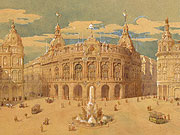Genoa Stock Exchange: the locations and the historical events
Founding
The origins of Genoa's credit securities market dates back many centuries before the era of Napoleonic domination. As early as the 14th century, bankers and moneychangers met at the Loggia in the Piazza dei Banchi, where trading continued to take place until the end of the 18th century.
The establishment of a Merchandise Exchange by the French authorities was long opposed by the Genovese merchant class, who considered the existing market to be more than adequate in a period when the city's economic prosperity was at a low.
The first law on the Genoa Exchange was issued in 1839, but its official founding was sanctioned by Royal Decree 1020 of 18 August 1855.
The Genoa Stock Exchange, which was made separate from the Merchandise Exchange in 1912, underwent the same institutional transformations as the other Italian stock exchanges from the Law of 1913 to the reforms of the 1990s, until closing down on 28 February 1994, the last day of floor trading.
The Market
The Genovese exchange marketplace was one of the main centres of development for the European financial system in the modern era. Genoa's star had already begun to fade, however, by the time modern-day merchandise exchanges arose in Italy under the stimulus of Napoleonic rule.
When Genoa was integrated into the Italian national system, the city became the leading commercial marketplace of the country, where the headquarters of the principal banks and modern commercial enterprises were located. The list at the Genoa Exchange, where trading in equity shares was already taking place before 1855, was historically dominated by maritime, food and mining companies.
The primacy of the Genoa Stock Exchange over the others in the Italian system began to be challenged around the end of the 19th century by the growth of the Milan marketplace, which established itself as the main financial hub of the country after the 1907 crisis.
Premises
 The historic seat where the Genovese merchants met was the Loggia dei Banchi, located in the building of the same name. The Loggia was abandoned at the end of the 18th century but became the seat of the Exchange meetings again in 1840 when, in a solemn ceremony, the City handed over the newly-restored premises to the Chamber of Commerce. In the meantime, in 1837, a room in the Palazzo delle Compere di San Giorgio had been set up for the meetings, which were held there for a number of years.
The historic seat where the Genovese merchants met was the Loggia dei Banchi, located in the building of the same name. The Loggia was abandoned at the end of the 18th century but became the seat of the Exchange meetings again in 1840 when, in a solemn ceremony, the City handed over the newly-restored premises to the Chamber of Commerce. In the meantime, in 1837, a room in the Palazzo delle Compere di San Giorgio had been set up for the meetings, which were held there for a number of years.
In 1855, when the Merchandise Exchange was formally established, the Loggia was considered to be too confined so the Chamber of Commerce rented space inside the Palazzo Senarega, facing the Loggia. These new premises were not popular with the brokers, however, who preferred other meeting places and continued to gather at the Loggia dei Banchi, where the Exchange was re-established in 1859 after a second restoration. During the 1880s, the merchandise brokers began to meet elsewhere, while trading of securities continued to take place in the Loggia. At the beginning of the 20th century, as part of the city's urban transformation, the Palazzo della Borsa was constructed in Piazza De Ferrari, Genoa's new business centre. The new Stock Exchange was inaugurated on 20 July 1912 and, after three days of solemn festivities, trading began on 22 July 1912.
